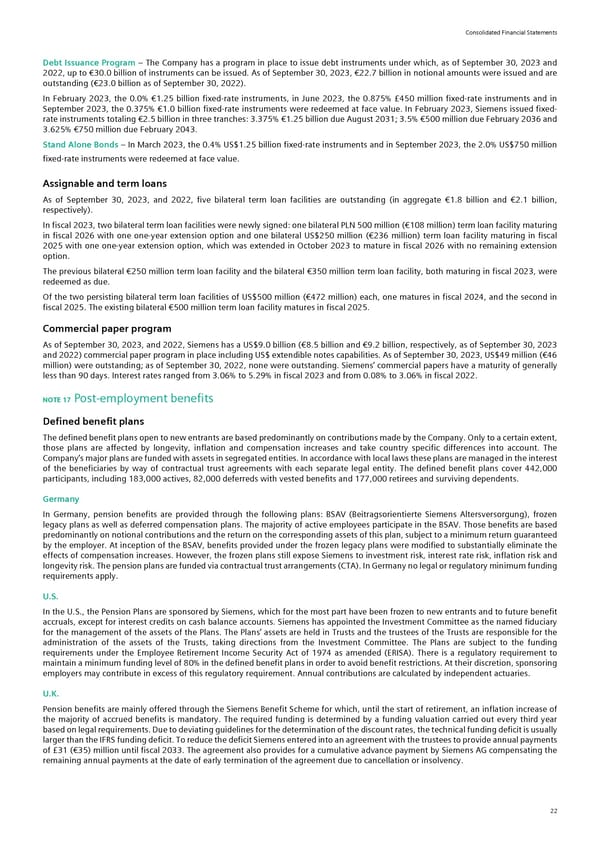Consolidated Financial Statements Debt Issuance Program – The Company has a program in place to issue debt instruments under which, as of September 30, 2023 and 2022, up to €30.0 billion of instruments can be issued. As of September 30, 2023, €22.7 billion in notional amounts were issued and are outstanding (€23.0 billion as of September 30, 2022). In February 2023, the 0.0% €1.25 billion fixed-rate instruments, in June 2023, the 0.875% £450 million fixed-rate instruments and in September 2023, the 0.375% €1.0 billion fixed-rate instruments were redeemed at face value. In February 2023, Siemens issued fixed- rate instruments totaling €2.5 billion in three tranches: 3.375% €1.25 billion due August 2031; 3.5% €500 million due February 2036 and 3.625% €750 million due February 2043. Stand Alone Bonds – In March 2023, the 0.4% US$1.25 billion fixed-rate instruments and in September 2023, the 2.0% US$750 million fixed-rate instruments were redeemed at face value. Assignable and term loans As of September 30, 2023, and 2022, five bilateral term loan facilities are outstanding (in aggregate €1.8 billion and €2.1 billion, respectively). In fiscal 2023, two bilateral term loan facilities were newly signed: one bilateral PLN 500 million (€108 million) term loan facility maturing in fiscal 2026 with one one-year extension option and one bilateral US$250 million (€236 million) term loan facility maturing in fiscal 2025 with one one-year extension option, which was extended in October 2023 to mature in fiscal 2026 with no remaining extension option. The previous bilateral €250 million term loan facility and the bilateral €350 million term loan facility, both maturing in fiscal 2023, were redeemed as due. Of the two persisting bilateral term loan facilities of US$500 million (€472 million) each, one matures in fiscal 2024, and the second in fiscal 2025. The existing bilateral €500 million term loan facility matures in fiscal 2025. Commercial paper program As of September 30, 2023, and 2022, Siemens has a US$9.0 billion (€8.5 billion and €9.2 billion, respectively, as of September 30, 2023 and 2022) commercial paper program in place including US$ extendible notes capabilities. As of September 30, 2023, US$49 million (€46 million) were outstanding; as of September 30, 2022, none were outstanding. Siemens’ commercial papers have a maturity of generally less than 90 days. Interest rates ranged from 3.06% to 5.29% in fiscal 2023 and from 0.08% to 3.06% in fiscal 2022. NOTE 17 Post-employment benefits Defined benefit plans The defined benefit plans open to new entrants are based predominantly on contributions made by the Company. Only to a certain extent, those plans are affected by longevity, inflation and compensation increases and take country specific differences into account. The Company’s major plans are funded with assets in segregated entities. In accordance with local laws these plans are managed in the interest of the beneficiaries by way of contractual trust agreements with each separate legal entity. The defined benefit plans cover 442,000 participants, including 183,000 actives, 82,000 deferreds with vested benefits and 177,000 retirees and surviving dependents. Germany In Germany, pension benefits are provided through the following plans: BSAV (Beitragsorientierte Siemens Altersversorgung), frozen legacy plans as well as deferred compensation plans. The majority of active employees participate in the BSAV. Those benefits are based predominantly on notional contributions and the return on the corresponding assets of this plan, subject to a minimum return guaranteed by the employer. At inception of the BSAV, benefits provided under the frozen legacy plans were modified to substantially eliminate the effects of compensation increases. However, the frozen plans still expose Siemens to investment risk, interest rate risk, inflation risk and longevity risk. The pension plans are funded via contractual trust arrangements (CTA). In Germany no legal or regulatory minimum funding requirements apply. U.S. In the U.S., the Pension Plans are sponsored by Siemens, which for the most part have been frozen to new entrants and to future benefit accruals, except for interest credits on cash balance accounts. Siemens has appointed the Investment Committee as the named fiduciary for the management of the assets of the Plans. The Plans’ assets are held in Trusts and the trustees of the Trusts are responsible for the administration of the assets of the Trusts, taking directions from the Investment Committee. The Plans are subject to the funding requirements under the Employee Retirement Income Security Act of 1974 as amended (ERISA). There is a regulatory requirement to maintain a minimum funding level of 80% in the defined benefit plans in order to avoid benefit restrictions. At their discretion, sponsoring employers may contribute in excess of this regulatory requirement. Annual contributions are calculated by independent actuaries. U.K. Pension benefits are mainly offered through the Siemens Benefit Scheme for which, until the start of retirement, an inflation increase of the majority of accrued benefits is mandatory. The required funding is determined by a funding valuation carried out every third year based on legal requirements. Due to deviating guidelines for the determination of the discount rates, the technical funding deficit is usually larger than the IFRS funding deficit. To reduce the deficit Siemens entered into an agreement with the trustees to provide annual payments of £31 (€35) million until fiscal 2033. The agreement also provides for a cumulative advance payment by Siemens AG compensating the remaining annual payments at the date of early termination of the agreement due to cancellation or insolvency. 22
 Siemens Report FY2023 Page 67 Page 69
Siemens Report FY2023 Page 67 Page 69